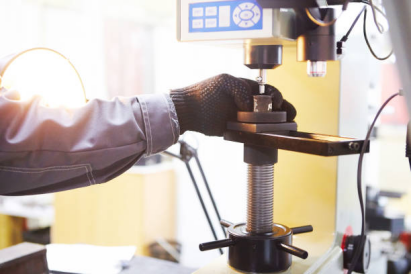In the casting industry, the hardness of castings is one of the key indicators for measuring their quality and performance. The hardness of castings not only directly affects their usability and lifespan but also influences the overall reliability and safety of the final product. This article will provide a detailed explanation of the importance of casting hardness and the main factors affecting it, helping readers gain a comprehensive understanding of this critical parameter.
一、Importance of Casting Hardness
1.1Mechanical Properties
Wear Resistance: Higher hardness in castings results in better wear resistance. Under conditions of significant friction, high-hardness castings are less prone to wear, thereby extending their service life.
Strength: Castings with higher hardness generally exhibit greater strength, maintaining structural stability in complex working environments and reducing the risk of fracture.
Stiffness: High-hardness castings offer better stiffness, making them less susceptible to deformation, especially under heavy loads, ensuring optimal performance.
1.2Machinability
Machining Performance: Castings with moderate hardness allow for better control of tool wear during machining, thereby improving processing accuracy and efficiency.
Surface Quality: Materials with uniform and appropriate hardness result in smoother surfaces after machining, reducing the difficulty of subsequent finishing processes.
1.3Operational Reliability
Durability: High-hardness castings are less prone to fatigue cracks during long-term use, enhancing the overall durability of the system.
Safety: In critical applications such as aerospace and automotive manufacturing, the hardness of castings directly impacts the safety performance of the final product.
二、Factors Affecting Casting Hardness
2.1Alloy Composition
Base Metal: Different metals exhibit significant variations in hardness. For example, copper alloys are generally softer than aluminum alloys, while aluminum alloys are softer than steel.
Alloying Elements: Adding appropriate alloying elements (e.g., carbon, silicon, manganese, chromium) can significantly enhance the hardness of castings. For instance, carbon increases the hardness of steel, while silicon improves the hardness of aluminum alloys.
2.2Casting Process
Pouring Temperature: Excessively high or low pouring temperatures can adversely affect hardness. High temperatures may lead to coarse grains, reducing hardness, while low temperatures can cause uneven internal structures, similarly impacting hardness.
Cooling Rate: Rapid cooling refines grain structure, thereby increasing hardness. However, excessively fast cooling may lead to increased internal stress or even cracking.
Heat Treatment: Processes such as quenching and tempering can further adjust the hardness of castings. A well-designed heat treatment process can achieve optimal hardness values.
2.3.Mold Conditions
Mold Material: The material of the mold can influence casting hardness. High-quality molds allow better control of the forming process, thereby improving hardness.
Mold Temperature: Improper mold temperatures (too high or too low) can affect the cooling rate of castings, subsequently impacting hardness. An appropriate mold temperature helps achieve uniform hardness distribution.
Mold Design: A well-designed mold ensures consistent cooling rates across different sections of the casting, preventing localized hardness deficiencies.
2.4Post-Processing
Machining: Proper machining can remove surface defects, resulting in more uniform hardness.
Surface Treatment: Processes such as carburizing or nitriding can further enhance surface hardness, improving wear and corrosion resistance.
三、Methods for Testing Casting Hardness
Brinell Hardness Test: A commonly used method for larger castings. It involves applying a specific pressure with a hard indenter, measuring the indentation diameter, and calculating the hardness value.
Rockwell Hardness Test: Suitable for thinner or smaller castings. This method applies preload and main loads, measures the indentation depth, and derives the hardness value.
Vickers Hardness Test: Applicable to castings of various sizes and shapes. It uses a pyramidal diamond indenter to apply pressure, measures the diagonal length of the indentation, and calculates the hardness value.
3.1Conclusion
In summary, casting hardness is a critical parameter for evaluating performance, directly impacting the usability and lifespan of castings. To achieve ideal hardness, it is essential to consider factors such as alloy composition, casting process, mold conditions, and post-processing. Only by effectively controlling these factors can high-quality castings be produced to meet the application requirements of various industries.
3.2Casting Process
Pouring Temperature: Excessively high or low pouring temperatures can adversely affect hardness. High temperatures may lead to coarse grains, reducing hardness, while low temperatures can cause uneven internal structures, similarly impacting hardness.
Cooling Rate: Rapid cooling refines grain structure, thereby increasing hardness. However, excessively fast cooling may lead to increased internal stress or even cracking.
Heat Treatment: Processes such as quenching and tempering can further adjust the hardness of castings. A well-designed heat treatment process can achieve optimal hardness values.
3.2Mold Conditions
Mold Material: The material of the mold can influence casting hardness. High-quality molds allow better control of the forming process, thereby improving hardness.
Mold Temperature: Improper mold temperatures (too high or too low) can affect the cooling rate of castings, subsequently impacting hardness. An appropriate mold temperature helps achieve uniform hardness distribution.
Mold Design: A well-designed mold ensures consistent cooling rates across different sections of the casting, preventing localized hardness deficiencies.
3.4Post-Processing
Machining: Proper machining can remove surface defects, resulting in more uniform hardness.
Surface Treatment: Processes such as carburizing or nitriding can further enhance surface hardness, improving wear and corrosion resistance.
四、Methods for Testing Casting Hardness
Brinell Hardness Test: A commonly used method for larger castings. It involves applying a specific pressure with a hard indenter, measuring the indentation diameter, and calculating the hardness value.
Rockwell Hardness Test: Suitable for thinner or smaller castings. This method applies preload and main loads, measures the indentation depth, and derives the hardness value.
Vickers Hardness Test: Applicable to castings of various sizes and shapes. It uses a pyramidal diamond indenter to apply pressure, measures the diagonal length of the indentation, and calculates the hardness value.
4.1Conclusion
In summary, casting hardness is a critical parameter for evaluating performance, directly impacting the usability and lifespan of castings. To achieve ideal hardness, it is essential to consider factors such as alloy composition, casting process, mold conditions, and post-processing. Only by effectively controlling these factors can high-quality castings be produced to meet the application requirements of various industries.

